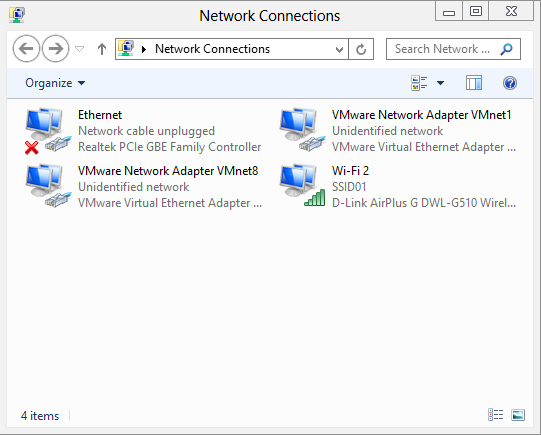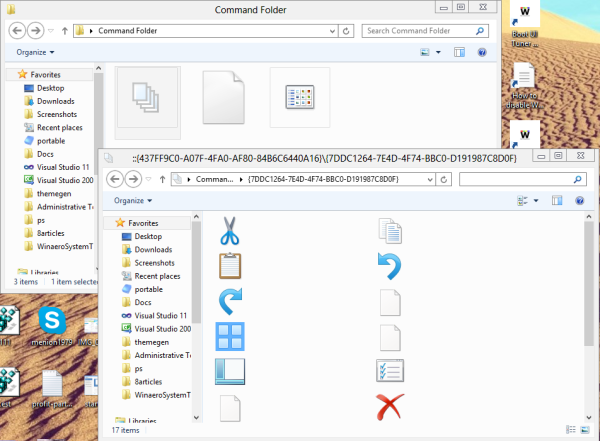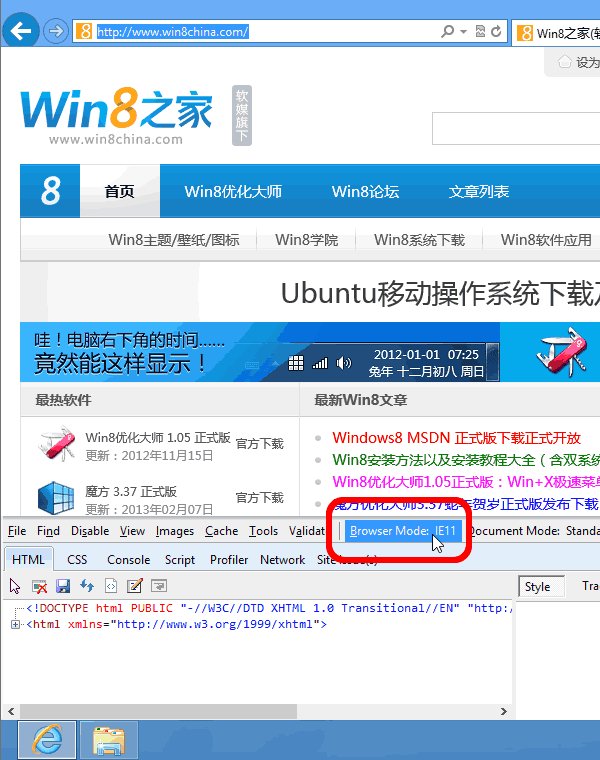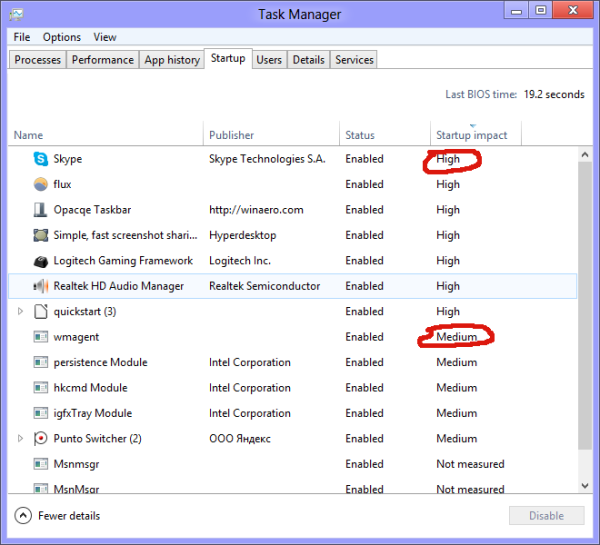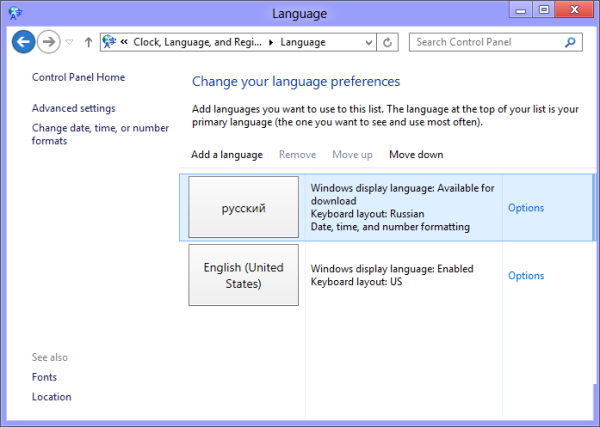Many people, including my friends, often ask me how to change a Windows theme from the command prompt without opening the Explorer window. They want to apply the custom theme they have installed from the command line. Unfortunately, Windows does not provide any native or user-friendly way to change the current theme and apply *.theme file silently. Today, I would like to provide you with an easy-to-use solution - our brand new release: Winaero Theme Switcher.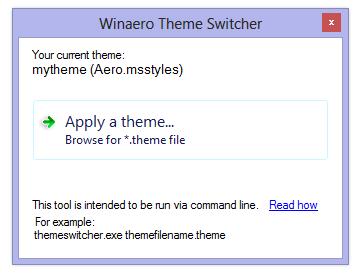
Category: Windows 8
How to prevent Windows 8 from auto pinning apps to the Start screen
If you have been using Windows 8, you would definitely have noticed that it automatically pins every application shortcut to the Start screen. This is highly unwanted behavior because your Start screen will become cluttered very quickly. Today I would like to share with you a simple and useful trick which will give you a clean and well organized Start screen. Continue if you are interested.
The full list of shell commands in Windows 8
Earlier, we have covered the most comprehensive list of shell locations by their Class ID which you can use to create a shortcut to the specific shell location for quick access. Today I am going to share the list of shell commands using their friendly name. Although these are implemented by the same ActiveX objects, you will notice that not every shell location with a CLSID has a user friendly alias. For example, 'Devices and Printers', the one with the shell:::{A8A91A66-3A7D-4424-8D24-04E180695C7A} CLSID has no friendly-name equivalent.
In the general case, a shell command looks like this:
shell:Friendly Folder Name
For example,
- shell:SendTo - the folder with items that you see in the "Send to" menu
- shell:Desktop - the Desktop folder, and so on.
Read the the full list below of such commands in Windows 8.
How to enable fast XP-like Event Viewer in Windows 8
NT6, whose era started with Windows Vista, has introduced a new Event Viewer with blackjack and hookers filters and categories. Although they are quite useful and allow you to locate any system event/error easily, the Event Viewer is VERY slow. Those of us who have used Windows XP/2000 still remember how fast and compact the Event Viewer was in Windows XP. It can still be useful if you only quickly want to see the last few events which happened on your system. Windows Vista, 7 and Windows 8 still contain the old Event Viewer application, but it is just not enabled by default. Today I am going to share with you how to enable it.
The most comprehensive list of shell locations in Windows 8
There are lots of shell locations in Windows, that you can access via shell:::{GUID} commands from the "Run" dialog. They are also known as "Shell Folders". With each version of Windows, many new shell locations are added.
What are Shell Folders
Shell folders are ActiveX objects that implement a special virtual folder or a virtual applet. In some cases, they provide access to physical folders on your hard drive or even to special OS functionality like "Minimize all Windows" or the Alt+Tab switcher.
What you can do with Shell Folders
You can use them in various scenarios, but in the general case you can use them to create a shortcut to a specific Control Panel applet or a Windows feature. For example, the following command will open the "Network Connections" folder:
shell:::{7007ACC7-3202-11D1-AAD2-00805FC1270E}Note: Press Win+R keys on your keyboard, copy the command above and paste it in the "Run" dialog.
The following command will open Control panel always in "Category" view:
shell:::{26EE0668-A00A-44D7-9371-BEB064C98683}And the following command will open Control Panel in icon-view, either small or large, that was set by the user the last time he opened it.
shell:::{5399E694-6CE5-4D6C-8FCE-1D8870FDCBA0}There are lots of interesting things there. You may already know the famous so called God Mode/All Tasks shell location. Another interesting one that I have found is the "Command Folder" that represents Explorer ribbon/toolbar commands:
shell:::{437ff9c0-a07f-4fa0-af80-84b6c6440a16}The result looks as follows:
Today I would like to share with you the most comprehensive list of shell locations I have discovered in Windows 8.
Internet Explorer 11 will be shipped with Windows 8.1 (aka ‘Blue’)
According to Win8China, Internet Explorer 11 is currently in development and will be included in the next major update to Windows named "Windows 8.1" (aka 'Blue') that is expected to be released this summer.
How to open a new window of a desktop app from the Start screen
In Windows 8, whenever you launch a second instance (new window) of an already running desktop app, the Start screen does not launch a new instance of that app. It merely switches to the already running desktop app's window. This can be highly annoying.
To open another window of the same program, you have to either Shift+click on the Desktop app's tile or right click and choose "Open new window". The behavior in earlier Windows versions which had the Start Menu was different. The Start menu always always launched a new instance of an app.
Luckily, there exists a way to allow us to control this behavior. Let's see how.
How to properly restart the Explorer shell in Windows
Windows provides several secret ways to exit the Explorer shell. They can be useful when you make registry changes that affect Explorer or for shell developers when testing shell extensions. In case you didn't know them, today I am going to share them with you.
Why you may want to restart Explorer
There are several reasons when you may want to exit the Explorer shell and start it again, such as:
- You are trying to uninstall some software with shell extensions, e.g. WinRAR. If you leave Explorer, all shell extensions will be unloaded from the shell and will be cleanly deleted by the uninstaller. All files that are locked for use by the Explorer.exe process will be released.
- If you applied some tweak which requires you to log off and log in back, in most cases, it is enough to only restart the shell.
Let's see how this can be done.
How Task Manager calculates “Startup Impact” of Apps
If you are a Windows 8 user, you must have observed that the new Task Manager has a Startup tab to manage applications loaded at startup. It includes an interesting "Startup impact" column:
I would like to explain to you what exactly the "startup impact" values mean and how they are calculated for every application.
Configuring language settings in Windows 8
With Windows 8, Microsoft has "re-imagined" the Language settings Control Panel. The most notable changes have been made to the way users switch input languages and to the Language Bar. Even some power users have been having issues with configuring language settings and have been asking me for help when they moved to Windows 8. So, today I will share several tips to make your life with configuring languages on Windows 8 easier.
